登録情報 データベース : EMDB / ID : EMD-24248タイトル Partial C. difficile TcdB and CSPG4 fragment Partial C. difficile TcdB with CSPG4 (410-560) 複合体 : The complex of TcdB and CSPG4 fragment細胞器官・細胞要素 : Ternary structure of C-terminus of CSPG4 domain 1タンパク質・ペプチド : Chondroitin sulfate proteoglycan 4細胞器官・細胞要素 : Ternary structure of Clostridium difficile TcdB / 機能・相同性 分子機能 ドメイン・相同性 構成要素
/ / / / / / / / / / / / / / / / / / / / / / / / / / / / / / / / / / / / / / / / / / / / / / / / / / / / / / / / / / / / / / / / / / / / / / / / / / / / / / / / / / / / / / / / 生物種 Clostridioides difficile (バクテリア) / Homo sapiens (ヒト)手法 / / 解像度 : 3.4 Å Jiang M / Zhang J 資金援助 Organization Grant number 国 Welch Foundation National Institutes of Health/National Center for Research Resources (NIH/NCRR)
ジャーナル : To Be Published タイトル : Structural Basis for Receptor Recognition of Clostridium difficile Toxin B and its Dissociation upon Acidification著者 : Jiang M / Zhang J 履歴 登録 2021年6月16日 - ヘッダ(付随情報) 公開 2022年3月2日 - マップ公開 2022年3月2日 - 更新 2025年5月14日 - 現状 2025年5月14日 処理サイト : RCSB / 状態 : 公開
すべて表示 表示を減らす
 データを開く
データを開く 基本情報
基本情報 マップデータ
マップデータ 試料
試料 キーワード
キーワード 機能・相同性情報
機能・相同性情報 Clostridioides difficile (バクテリア) /
Clostridioides difficile (バクテリア) /  Homo sapiens (ヒト)
Homo sapiens (ヒト) データ登録者
データ登録者 米国, 2件
米国, 2件  引用
引用 ジャーナル: To Be Published
ジャーナル: To Be Published 構造の表示
構造の表示 ムービービューア
ムービービューア SurfView
SurfView Molmil
Molmil Jmol/JSmol
Jmol/JSmol ダウンロードとリンク
ダウンロードとリンク emd_24248.map.gz
emd_24248.map.gz EMDBマップデータ形式
EMDBマップデータ形式 emd-24248-v30.xml
emd-24248-v30.xml emd-24248.xml
emd-24248.xml EMDBヘッダ
EMDBヘッダ emd_24248.png
emd_24248.png emd-24248.cif.gz
emd-24248.cif.gz http://ftp.pdbj.org/pub/emdb/structures/EMD-24248
http://ftp.pdbj.org/pub/emdb/structures/EMD-24248 ftp://ftp.pdbj.org/pub/emdb/structures/EMD-24248
ftp://ftp.pdbj.org/pub/emdb/structures/EMD-24248 emd_24248_validation.pdf.gz
emd_24248_validation.pdf.gz EMDB検証レポート
EMDB検証レポート emd_24248_full_validation.pdf.gz
emd_24248_full_validation.pdf.gz emd_24248_validation.xml.gz
emd_24248_validation.xml.gz emd_24248_validation.cif.gz
emd_24248_validation.cif.gz https://ftp.pdbj.org/pub/emdb/validation_reports/EMD-24248
https://ftp.pdbj.org/pub/emdb/validation_reports/EMD-24248 ftp://ftp.pdbj.org/pub/emdb/validation_reports/EMD-24248
ftp://ftp.pdbj.org/pub/emdb/validation_reports/EMD-24248 リンク
リンク EMDB (EBI/PDBe) /
EMDB (EBI/PDBe) /  EMDataResource
EMDataResource マップ
マップ ダウンロード / ファイル: emd_24248.map.gz / 形式: CCP4 / 大きさ: 22.2 MB / タイプ: IMAGE STORED AS FLOATING POINT NUMBER (4 BYTES)
ダウンロード / ファイル: emd_24248.map.gz / 形式: CCP4 / 大きさ: 22.2 MB / タイプ: IMAGE STORED AS FLOATING POINT NUMBER (4 BYTES) 試料の構成要素
試料の構成要素 Clostridioides difficile (バクテリア)
Clostridioides difficile (バクテリア) Homo sapiens (ヒト)
Homo sapiens (ヒト) Clostridioides difficile (バクテリア)
Clostridioides difficile (バクテリア) Homo sapiens (ヒト)
Homo sapiens (ヒト) Homo sapiens (ヒト)
Homo sapiens (ヒト) Clostridioides difficile (バクテリア)
Clostridioides difficile (バクテリア) Bacillus megaterium NBRC 15308 = ATCC 14581 (バクテリア)
Bacillus megaterium NBRC 15308 = ATCC 14581 (バクテリア) 解析
解析 試料調製
試料調製 電子顕微鏡法
電子顕微鏡法 FIELD EMISSION GUN
FIELD EMISSION GUN
 画像解析
画像解析
 ムービー
ムービー コントローラー
コントローラー



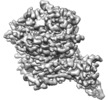















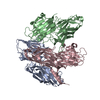
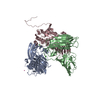





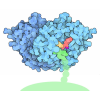
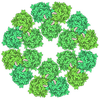
 Z (Sec.)
Z (Sec.) Y (Row.)
Y (Row.) X (Col.)
X (Col.)





















